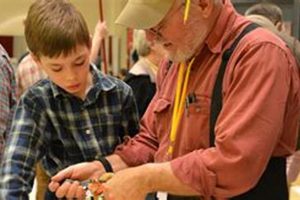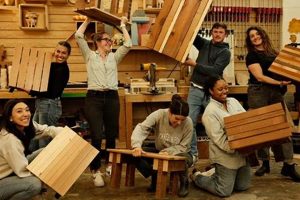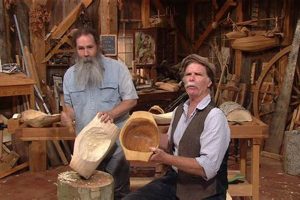The annual event held in Georgia’s capital serves as a significant gathering for professionals involved in the craft and industry of wood. This exhibition provides a concentrated venue for manufacturers, distributors, and end-users to connect and explore the latest advancements. It encompasses a wide array of tools, machinery, materials, and related technologies essential for woodworking and related fields.
The impact of this gathering extends beyond the immediate transactions occurring on the show floor. It offers opportunities for knowledge sharing, professional development, and the establishment of business relationships that can foster innovation and growth within the woodworking sector. Its history demonstrates a commitment to showcasing the evolution of techniques and technologies within the industry, contributing significantly to its overall advancement.
Subsequent sections will delve into the specific product categories presented at the show, the educational opportunities available to attendees, and the overall economic impact it has on the region and the wider woodworking community.
Exhibitor Strategies for Success
The following guidelines are intended to maximize an exhibitor’s engagement and return on investment at the major woodworking event in Atlanta.
Tip 1: Pre-Show Promotion: Implement a comprehensive marketing strategy prior to the event. This includes targeted email campaigns, social media engagement, and direct mail to potential clients. Clearly articulate the exhibitor’s value proposition and showcase any new product launches.
Tip 2: Strategic Booth Design: Ensure the booth design is visually appealing and effectively communicates the brand identity. Utilize professional lighting, clear signage, and product demonstrations to attract attendees. Consider incorporating interactive elements to enhance engagement.
Tip 3: Qualified Staffing: Staff the booth with knowledgeable and engaging personnel who can effectively answer questions, provide product demonstrations, and qualify leads. Ensure staff are thoroughly briefed on the exhibitor’s objectives and target audience.
Tip 4: Lead Capture and Management: Implement a robust lead capture system, such as badge scanning or electronic data collection, to efficiently gather attendee information. Develop a clear process for following up with leads promptly after the show.
Tip 5: Product Demonstrations and Training: Schedule regular product demonstrations and training sessions to highlight the capabilities and benefits of the exhibitor’s offerings. Provide hands-on experience whenever possible to enhance attendee understanding.
Tip 6: Networking Opportunities: Actively participate in networking events and industry gatherings associated with the exhibition. This provides opportunities to connect with potential partners, customers, and industry influencers.
Tip 7: Post-Show Follow-Up: Develop a comprehensive post-show follow-up strategy to nurture leads and convert them into sales. This includes personalized emails, phone calls, and targeted content delivery.
By implementing these strategies, exhibitors can enhance their presence at the woodworking trade show and maximize their return on investment. A well-executed plan, from pre-show promotion to post-show follow-up, is crucial for success.
The subsequent sections will analyze the technological innovations commonly showcased and the future trajectory of the woodworking industry as reflected in these gatherings.
1. Machinery
Machinery forms a central component of the annual woodworking exhibition in Atlanta. The event serves as a crucial platform for showcasing the latest advancements and innovations in equipment used across the woodworking industry, from primary processing to finishing.
- Primary Processing Equipment
This category encompasses machinery used for initial wood processing, such as sawing, shaping, and surfacing. Examples include industrial-scale band saws, planers, and molders. These machines are critical for transforming raw timber into usable lumber for various woodworking applications. At the show, manufacturers demonstrate the increased efficiency, precision, and safety features incorporated into these machines.
- Secondary Processing Equipment
Secondary processing machinery covers tools and equipment used for joinery, shaping, and detailing wooden components. Examples include routers, jointers, and mortisers. Exhibitors often showcase CNC (Computer Numerical Control) machines that automate and streamline these processes, offering increased accuracy and reduced labor requirements.
- Finishing Equipment
The exhibition includes a range of finishing equipment designed to apply protective and aesthetic coatings to wooden products. This includes spray booths, sanding machines, and automated finishing lines. Demonstrations focus on achieving consistent finishes, reducing material waste, and minimizing environmental impact.
- Hand Tools and Power Tools
While the exhibition focuses on large-scale machinery, hand tools and power tools also have a significant presence. Manufacturers display the latest innovations in saws, drills, sanders, and other essential tools, highlighting their ergonomic design, power efficiency, and durability.
The machinery displays at the woodworking show in Atlanta provide a comprehensive overview of the equipment landscape, enabling professionals to evaluate new technologies, compare products, and make informed purchasing decisions. The presence of both established manufacturers and emerging innovators contributes to the event’s importance as a hub for technological advancement in the woodworking industry.
2. Materials
A significant portion of the annual woodworking exhibition held in Atlanta is dedicated to the display and demonstration of various materials essential to the woodworking industry. These materials represent the raw components from which wood products are created, and their quality, availability, and innovative applications directly impact the industry’s output.
- Hardwoods and Softwoods
The foundation of woodworking lies in the selection of appropriate wood species. The exhibition features a wide array of both hardwoods, such as oak, maple, and cherry, known for their density and durability, and softwoods, including pine, fir, and cedar, valued for their workability and cost-effectiveness. Suppliers present information on sustainable sourcing, grading, and the unique properties of each wood type, enabling informed material selection for diverse projects.
- Wood Composites
Beyond solid wood, composite materials play an increasingly crucial role. The event showcases plywood, particleboard, medium-density fiberboard (MDF), and other engineered wood products. These materials offer advantages such as dimensional stability, affordability, and consistent quality. Exhibitors demonstrate their applications in furniture manufacturing, cabinetry, and construction, highlighting their versatility and performance characteristics.
- Adhesives and Fasteners
The structural integrity of wood products relies heavily on the quality of adhesives and fasteners. The exhibition includes displays of various adhesives, ranging from traditional wood glues to advanced epoxy resins. Fasteners, such as screws, nails, and bolts, are also prominently featured. Suppliers provide technical data on bond strength, curing times, and compatibility with different wood species and composite materials, ensuring proper assembly and long-term durability.
- Finishes and Coatings
The aesthetic appeal and protective qualities of wood products are enhanced through the application of finishes and coatings. The event features a diverse range of stains, paints, varnishes, lacquers, and sealants. Exhibitors showcase their products’ durability, resistance to moisture and UV damage, and impact on the wood’s appearance. They also provide information on application techniques and environmental considerations, ensuring optimal results and responsible finishing practices.
The comprehensive display of materials at the woodworking show in Atlanta serves as a valuable resource for woodworking professionals. It enables them to stay informed about the latest material innovations, evaluate product performance, and establish relationships with suppliers. The careful selection and application of appropriate materials are critical factors in achieving high-quality, durable, and aesthetically pleasing wood products, ultimately contributing to the success of the woodworking industry.
3. Technology
The annual woodworking exhibition held in Atlanta increasingly serves as a showcase for technological innovation within the woodworking sector. The integration of advanced technologies directly impacts manufacturing processes, material utilization, and design capabilities, fundamentally altering the industry’s landscape. This event provides a concentrated venue for observing these technological advancements, understanding their implications, and assessing their potential for implementation.
One key example is the proliferation of Computer Numerical Control (CNC) machinery. These systems automate complex cutting, shaping, and joinery operations, significantly increasing precision and efficiency. Another notable trend is the application of software solutions for design and modeling, enabling woodworkers to create intricate designs, optimize material usage, and simulate production processes before committing to physical fabrication. Furthermore, advancements in sensor technology and data analytics are enabling predictive maintenance on machinery, minimizing downtime and optimizing operational performance. These technologies and many others are demonstrated each year.
Ultimately, the integration of technology showcased at this event drives enhanced productivity, improved product quality, and reduced waste. The ability to understand and adopt these technological advancements is becoming increasingly critical for businesses seeking to maintain competitiveness in the global woodworking market. The convergence of technological innovation and practical application, as demonstrated at the exhibition, holds significant potential for shaping the future of the woodworking industry.
4. Education
The integration of educational opportunities at the prominent woodworking exhibition in Atlanta constitutes a crucial element of its overall value proposition. These educational initiatives cater to a diverse audience, ranging from seasoned professionals seeking to refine their skills to aspiring woodworkers eager to acquire foundational knowledge. The presence of robust educational programming enhances the event’s significance as a hub for industry knowledge dissemination and skill development.
- Seminars and Workshops
A core component of the educational offerings involves structured seminars and hands-on workshops. These sessions are typically led by industry experts and cover a wide range of topics, including advanced joinery techniques, efficient machine operation, sustainable material sourcing, and innovative design principles. For instance, a seminar might focus on optimizing CNC workflows, while a workshop could provide practical experience in applying specialized finishes. The direct application of these skills helps attendees improve their practices in the workplace.
- Product Demonstrations
Beyond formal educational settings, manufacturers frequently conduct live product demonstrations showcasing the features and capabilities of their equipment and materials. These demonstrations offer attendees the opportunity to observe best practices and ask questions directly to the product experts. A machinery demonstration, for example, might highlight the precision and efficiency of a new saw, or a material demonstration could focus on the application of a sustainable wood finish. These demonstrations provide a tangible understanding of product functionality and benefits.
- Expert Consultations
The exhibition often facilitates access to expert consultations, enabling attendees to engage in one-on-one discussions with industry leaders and technical specialists. These consultations offer personalized advice on specific challenges or projects. Attendees might seek guidance on optimizing their production processes, selecting appropriate materials for a specific application, or troubleshooting technical issues. The individualized nature of these consultations provides targeted support and accelerates skill development.
- Certification Programs
In some instances, the event hosts or facilitates access to industry-recognized certification programs. These programs provide formal recognition of skill proficiency and demonstrate a commitment to professional development. Certification opportunities may include areas such as machine operation, safety protocols, or sustainable woodworking practices. Successful completion of these programs enhances credibility and provides a competitive advantage in the job market.
The educational opportunities available at the woodworking show in Atlanta contribute to the long-term growth and sustainability of the industry. By providing access to knowledge, skills, and expert guidance, the event empowers professionals to enhance their capabilities, adopt best practices, and drive innovation within their respective organizations.
5. Networking
Networking represents a critical, often understated, facet of the annual woodworking exhibition. Its importance extends beyond mere social interaction, forming a foundation for collaboration, knowledge exchange, and business development within the woodworking sector. The concentrated gathering of professionals creates unique opportunities unavailable through typical channels.
- Manufacturer-Distributor Partnerships
The exhibition serves as a prime venue for manufacturers to connect with distributors, both domestic and international. These interactions can lead to expanded market reach for manufacturers and access to innovative products for distributors. For example, a small tool manufacturer might secure a distribution agreement with a larger company, significantly increasing its sales volume. These partnerships are often initiated and cultivated through face-to-face interactions at the event.
- Peer-to-Peer Knowledge Exchange
Professionals from various woodworking businesses, including furniture makers, cabinet shops, and custom woodworking firms, utilize the event for knowledge exchange. Sharing insights on best practices, troubleshooting challenges, and exploring new techniques enhances individual expertise and collectively elevates industry standards. A panel discussion or informal conversation might reveal a more efficient method for a specific woodworking task, benefiting attendees. This level of information sharing is very hard to replicate elsewhere.
- Supplier-Customer Relationships
Direct interaction between suppliers of raw materials, machinery, and finishing products with their customer base facilitates a deeper understanding of needs and preferences. This understanding informs product development and service offerings. For example, a supplier of woodworking adhesives might gather feedback on product performance and address customer concerns directly. These relationships promote ongoing improvement and strengthen the overall supply chain.
- Talent Acquisition and Recruitment
The exhibition provides opportunities for companies to identify and recruit skilled woodworkers and related professionals. Networking events, career fairs, and informal interactions can lead to valuable connections between employers and potential employees. A woodworking company facing a labor shortage might find qualified candidates attending the exhibition for professional development or industry engagement.
These networking opportunities, integral to the woodworking exhibition, contribute significantly to the industry’s vibrancy and innovation. They foster a collaborative environment where businesses and individuals can thrive, ultimately leading to advancements in woodworking techniques, technologies, and overall industry growth.
Frequently Asked Questions
The following addresses common inquiries concerning the annual woodworking exhibition held in Atlanta, aiming to provide clarity and pertinent information for prospective attendees and exhibitors.
Question 1: What are the dates and location for the upcoming show?
Specific dates and location details are typically announced well in advance through the official event website and associated marketing channels. Potential attendees should consult these sources for the most current information, as dates and venues may be subject to change.
Question 2: Who is the target audience for this event?
The event primarily targets woodworking professionals, including manufacturers, distributors, custom woodworkers, cabinet makers, furniture designers, and related industry personnel. The exhibition also attracts educators, students, and hobbyists with a serious interest in woodworking techniques and technologies.
Question 3: What types of products and services are typically showcased?
Exhibits encompass a broad spectrum of woodworking-related products and services, ranging from large-scale industrial machinery and hand tools to lumber, composite materials, adhesives, finishes, software solutions, and design services. The event provides a comprehensive overview of the resources available to the woodworking industry.
Question 4: Are there educational opportunities available for attendees?
The exhibition typically features a program of educational seminars, workshops, and product demonstrations conducted by industry experts. These sessions cover a wide range of topics, providing attendees with opportunities to enhance their skills, learn about new technologies, and stay abreast of industry trends.
Question 5: How can interested parties register to attend or exhibit?
Registration for both attendees and exhibitors is generally handled through the official event website. Prospective attendees can typically register online and purchase admission passes. Exhibitors must apply for booth space and meet specific eligibility requirements. Early registration is often encouraged to secure favorable rates and booth locations.
Question 6: What is the economic impact of this exhibition on the Atlanta region?
The event generates significant economic activity in the Atlanta region, attracting attendees and exhibitors from across the country and around the world. This influx of visitors supports local hotels, restaurants, transportation services, and other businesses, contributing to the overall economic vitality of the area.
The preceding questions and answers offer a fundamental understanding of the prominent woodworking trade show. Individuals should consult official sources for detailed specifics.
Future article sections may explore emerging trends to watch at next year’s gathering.
Conclusion
The annual woodworking exhibition in Atlanta serves as a critical nexus point for the industry. This article has explored its multiple facets, including the display of machinery, materials, and technological advancements, as well as the educational and networking opportunities afforded to attendees. The event’s comprehensive nature positions it as a significant driver of progress within the woodworking sector.
The continued success of this gathering is essential for fostering innovation, promoting best practices, and facilitating connections among industry stakeholders. Participation, whether as an exhibitor or attendee, represents a strategic investment in the future of woodworking.







